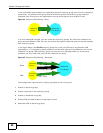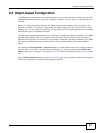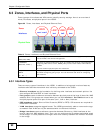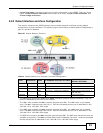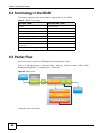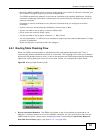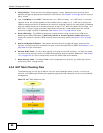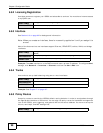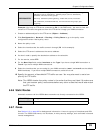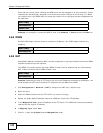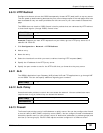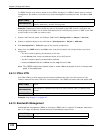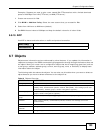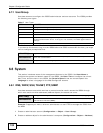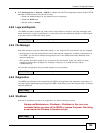
Chapter 6 Configuration Basics
ISG50 User’s Guide
98
6.6.2 Licensing Registration
Use these screens to register your ISG50 and subscribe to services. You must have Internet access
to myZyXEL.com.
6.6.3 Interface
See Section 6.3 on page 92 for background information.
Note: When you create an interface, there is no security applied on it until you assign it to
a zone.
Most of the features that use interfaces support Ethernet, PPPoE/PPTP, cellular, VLAN, and bridge
interfaces.
Example: The dmz interface is in the DMZ zone and uses a private IP address. To configure dmz’s
settings, click Network > Interface > Ethernet and then the dmz’s Edit icon.
6.6.4 Trunks
Use trunks to set up load balancing using two or more interfaces.
Example: See Chapter 7 on page 107.
6.6.5 Policy Routes
Use policy routes to override the ISG50’s default routing behavior in order to send packets through
the appropriate interface or VPN tunnel. You can also use policy routes for bandwidth management
(out of the ISG50), port triggering, and general NAT on the source address. You have to set up the
criteria, next-hops, and NAT settings first.
MENU ITEM(S)
Configuration > Licensing > Registration
PREREQUISITES
Internet access to myZyXEL.com
MENU ITEM(S)
Configuration > Network > Interface (except Network > Interface >
Trunk)
PREREQUISITES
Port groups (configured in the Interface > Port Grouping screen)
WHERE USED
Zones, trunks, IPSec VPN, DDNS, policy routes, static routes, HTTP redirect, NAT
MENU ITEM(S)
Configuration > Network > Interface > Trunk
PREREQUISITES
Interfaces
WHERE USED
Policy routes
MENU ITEM(S)
Configuration > Network > Routing > Policy Route



